I know I said I’ll continue posting my ‘The Lord of the Rings’ review, but since that is taking rather longer to complete, I thought I’d write a couple of posts on news that is more pressing and currently ‘hot’.
I’ve waited 11 months for it. Craved it. Desired it. And now finally, I managed to acquire and watch the 13-minutes of added footage to ‘An Unexpected Journey’ – allowing me to compile a brief overview of the new scenes and what I make of them.
Considering there was no booklet in the box set, detailing the film’s scenes list, I’ve had to “invent” the titles for the extended sequences.
Naturally, beware of some content spoilers …
– Thranduil’s Feud
The concept of viewing extended editions is that you get very insightful scenes into the motivations of characters – often remaining unseen in the theatrical version; 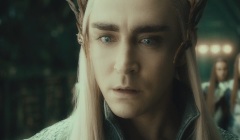 occasionally, leaving audiences somewhat confused as to why certain individuals behave in particular ways.
occasionally, leaving audiences somewhat confused as to why certain individuals behave in particular ways.
Carefully re-inserted scenes provide much more information and seem to increase the scope and breadth of a story as it progresses.
Case in point, Thranduil’s arrival at Erebor in the prologue.
As an older Bilbo’s voiceover accompanies the visuals, we learn that Thranduil – having come to pay his respects to Thror’s ever-growing power – has a particular weakness for gems (an important fact noted in the book).
The scene depicts a “deal-gone-wrong” type of moment, where the dwarves refuse to hand over a chest filled with gems – leaving the Elven King with bitter resentment as he leaves the court room.
 Here we finally begin to understand why these particular Dwarves and Elves do not see eye-to-eye, and perhaps, why Thranduil refused to help the exiles of Erebor after Smaug’s attack.
Here we finally begin to understand why these particular Dwarves and Elves do not see eye-to-eye, and perhaps, why Thranduil refused to help the exiles of Erebor after Smaug’s attack.
In just a few seconds, Peter Jackson, manages to brilliantly provide the necessary exposition and partial motivations of these individuals – which will climax during a confrontation in ‘The Desolation of Smaug’, between Thranduil and Thorin.
– The Destruction of Dale
Unlike ‘The Lord of the Rings’ Trilogy, the extended edition of ‘An Unexpected Journey’ has little to offer in terms of new, fleshed-out scenes; its intention seems focused on adding up the 13 minutes of promised footage, by means of various shots inserted here and there throughout a number of sequences.
During the prologue, as Smaug unleashes his fury against the inhabitants of Dale, we get no more than 4 or 5 shots – quickly played out one after the other – of Girion (the lord of Dale), arming a ballista and failing to pierce the dragon’s scaly hide.
It’s a pity that this moment plays out so fast – barely making us able to process what is going on the screen – however, it will be an essential seed to the backstory of Bard the Bowman, introduced in ‘The Desolation of Smaug’.
Whilst we do not yet know who this character is (Girion), nor the meaning of the black arrows, they will prove to be invaluable when the story reaches a specific climax in either film two or three.
From the new trailers it seems that this flashback, of Dale being destroyed, will be revisited in film 2 and most probably fleshed out even more; no doubt in conjunction with the introduction of Bard.
Furthermore, these new shots give us a very obscure (but tantalizing) glimpse into the overall shape of Smaug as he flies over the burning battlements and city ruins.
[Note: a further change is made in one of the shots of Smaug bursting through the gates of Erebor. In the theatrical version, the dragon’s forelegs trample over the fleeing dwarves, whilst in the extended edition these have been replaced with claws attached to the wingspan. On the alteration of Smaug’s body, see my previous post: ‘Dragons vs Wyverns: The Question of Smaug’]
– The Old Took’s Birthday Party
The lack of Hobbiton and hobbits in general was sorely missed in the theatrical of ‘An Unexpected Journey’. No wonder then that this scene feels like a breath of fresh air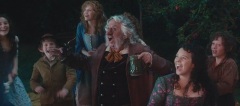 as we witness Gandalf’s famous fireworks bursting over the Shire at the Old Took’s (Bilbo’s ancestor) birthday.
as we witness Gandalf’s famous fireworks bursting over the Shire at the Old Took’s (Bilbo’s ancestor) birthday.
As hobbits dance around the festive atmosphere (very much reminding us of Bilbo’s own Birthday party in ‘The Fellowship of the Ring’), a young hobbit boy cheekily pulls at Gandalf’s cloak – whilst holding a toy-sword shaped in the likeness of Sting (Bilbo’s own sword found in the Troll’s cave).
 This hobbit is Bilbo himself as he gets his first glimpse of the wizard and his pyrotechnic spectacle.
This hobbit is Bilbo himself as he gets his first glimpse of the wizard and his pyrotechnic spectacle.
Yet again, this is a lovely little scene that (although may not be necessary for general audiences), is a gold mine to fans of the book and provide a further glimpse of our character’s past – making the ‘Good Morning’ sequence even more relevant as we now know of how the two individuals first met, years prior.
– At the Hobbiton Market
In the theatrical version, after Bilbo’s encounter with Gandalf, the scene cuts to the hobbit sitting quietly at Bag End, about to eat a piece of fish …
A new scene shows us what happened in between these two events – showing Bilbo as he walks down to the Hobbiton Market; allowing us to witness, once again, the beauty and rustic qualities of the Shire and its inhabitants.
In a scene very much reminiscent of the opening of ‘The Fellowship of the Ring’, the visuals burst with an array of bright colours as hobbits of all ages are to be found engaged in different activities across the green plains of Hobbiton.
Not only do we get to see how Bilbo acquired the fish, but we are also witnesses of a short conversation between the hobbit and another individual, Mr. Worrywort (who later on, utters the famous: “Here! Mr. Bilbo, where’re off too?”.
– Bifur’s Axe
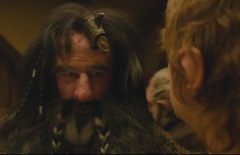 The only “extended” shot in the Unexpected Party sequence (apart from Dwarves grabbing more of Bilbo’s food) is a little exposition into Bifur’s character. We learn why he talks only in Khuzdul (the Dwarves’ language) and are referred his axe stuck in his head.
The only “extended” shot in the Unexpected Party sequence (apart from Dwarves grabbing more of Bilbo’s food) is a little exposition into Bifur’s character. We learn why he talks only in Khuzdul (the Dwarves’ language) and are referred his axe stuck in his head.
Not everyone may feel the same way about this little scene, but I find it very much enticing. General audiences who weren’t following the production stages of ‘The Hobbit’ may not have immediately grasped the concept around Bifur’s character and hence, adding this scene introduces much required dwarf exposition – albeit a very short one.
– The Magic of Rivendell
The next added scene comes in the form of a short conversation between Gandalf and Bilbo as the Company makes its way through a secret path before arriving in the Valley of Imladris.
The wizard asks the hobbit about a particular sensation he may be feeling – to which Bilbo promptly replies that it feels “like magic”. To me this is a very lovely scene  between the two individuals and somehow reflects another similar conversation in ‘The Fellowship of the Ring’ book – when Sam enquires about the “magic” of the Elves of Lothlórien.
between the two individuals and somehow reflects another similar conversation in ‘The Fellowship of the Ring’ book – when Sam enquires about the “magic” of the Elves of Lothlórien.
Here, in ‘An Unexpected Journey’, we have a hobbit who (like many viewers) is on the threshold of experiencing the beauty and majesty of the Elves for the first time. Even though he may have heard about them and about Rivendell, the act of being amongst them is a completely different experience.
Just like the exposition on Bifur’s axe, this scene would have worked brilliantly in the theatrical cut.
Simply wonderful.
– Rivendell
If you’ve read my review on ‘The Hobbit: An Unexpected Journey’, you may have come across my disappointment at the lack of Company-oriented scenes in Rivendell – mainly, of Bilbo himself.
Thankfully, the extended edition, does much to amend this most grievous error!
A fair chunk of those 13 minutes is dedicated to further exposition of the Dwarves (particularly their behaviour) and Bilbo’s understanding of larger and deeper issues within Middle-earth.
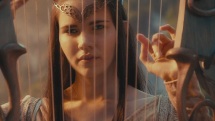 We begin with a delightful moment during the Company’s meal at Elrond’s table, with Kili and Dwalin sharing a conversation on the fairness of Elves. Eventually this escalates in a humorous outburst of festivity as we see Bofur’s character climbing on top of the table – as he begins reciting the famous “Man in the Moon” poem from ‘The Lord of the Rings’.
We begin with a delightful moment during the Company’s meal at Elrond’s table, with Kili and Dwalin sharing a conversation on the fairness of Elves. Eventually this escalates in a humorous outburst of festivity as we see Bofur’s character climbing on top of the table – as he begins reciting the famous “Man in the Moon” poem from ‘The Lord of the Rings’.
The Dwarves’ wild behaviour completely opposes Gandalf’s previous statement to Elrond about the proud descendants of the 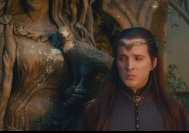 House of Durin, as the Company loses control and food ends up being heedlessly thrown around – much to the horror of the Elves nearby.
House of Durin, as the Company loses control and food ends up being heedlessly thrown around – much to the horror of the Elves nearby.
It is a further interesting insight into the characters of the Dwarves – once again emphasizing their love of life; but at the same time, not forgetting their loyal companionship, courage and pride.
***
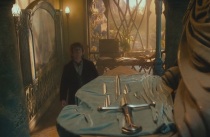 Finally, the much needed Bilbo-in-Rivendell moments are placed within the overall narrative as we witness the hobbit making his way among a well-known chamber in ‘The Lord of the Rings’.
Finally, the much needed Bilbo-in-Rivendell moments are placed within the overall narrative as we witness the hobbit making his way among a well-known chamber in ‘The Lord of the Rings’.
Bilbo looks intriguingly at the shards of Narsil (later to become Aragorn’s sword), whilst at the same time, eyeing with interest the painting depicting Isildur’s last stand against Sauron.
What is wonderful about this scene, is that, accompanied by Martin Freeman’s pitch-perfect expression of wonder and suspicion, we hear the sounds of battle in the background – clearly a reference to the Battle of Dagorlad as seen in the prologue to ‘The Fellowship of the Ring’.
Furthermore, Bilbo looks at the Ring on Sauron’s hand – unbeknownst to him that he himself will be acquiring that object very soon.
There’s something highly fascinating about this scene.
Perhaps it’s the innocence of the hobbit at being unable to comprehend the broader narrative outside his own journey. Maybe it’s the fact of not knowing that the Ring he sees on Sauron’s finger, will be the same evil Ring that will affect his character throughout much of his life.
Whatever it is, it’s one of those Peter Jackson/Middle-earth moments that just stay ingrained in your mind as the highlight of a particular sequence.
***
Continuing our discovery of Rivendell through the eyes of Bilbo, what follows is a montage of shots as the hobbit makes his way through the beautiful scenery – clearly at ease and contented at being in such a magical place.
He eventually finds himself confronted by Elrond himself. Yet again, this little piece of conversation has a special significance – tied to many concepts in Tolkien’s Middle-earth.
We see this interaction between a proud Elven lord and a small, feeble hobbit – finding themselves in a light-hearted “duel” about the special characteristics of their respective races. The camera angles further reinforce the authority of the Elf, but as the conversation progresses, we realize how wise Elrond is as a character and his offer for Bilbo to stay in Rivendell clearly demonstrates his supreme benevolence.
***
In the meantime, the Dwarves seem to be making the best of their stay among the Elves. Lindir expresses concern to Elrond about their behaviour and the dwindling stock of wine – with their conversation being suddenly cut off as they witness 13 dwarves, clearly lacking clothes, splashing around in one of the many fountains in Rivendell.
The only nagging thing about this scene is the obvious CGI of the dwarves bathing in the distance. Unfortunately, it is one of those shots in ‘An Unexpected Journey’ that seem to stand out for the wrong reasons.
I’d rather the filmmakers had not included this scene in the first place, or at least tried to portray the dwarves as realistically as possible. Considering the vast amount of impressive (and much more complicated) visual effects in this film, you’d think the end result of this shot would be much more up to standard.
***
Switching back to Bilbo, the hobbit finds himself one night eavesdropping on a conversation between Gandalf and Elrond – as they make their way to the White Council. He is soon joined by Thorin and both overhear the Elf disagreeing with the wizard’s quest and downplaying Thorin’s capabilities.
Whilst it might not be perceived as a crucial scene, it nevertheless resonates strongly with the relationship between Thorin and Bilbo – with the latter appearing to ponder these words in a sympathetic way towards the Dwarf Lord; paving the way towards those moments when the hobbit will eventually prove his worth to him.
– The Seven Rings of the Dwarves
As the White Council sequence takes place, a conversation between Gandalf and Saruman branches off towards the fate of the Seven rings given to the Dwarves – clearly  explaining that one of these was borne by Thror himself.
explaining that one of these was borne by Thror himself.
Apart from being a reference to the One Ring, there are hints in this scene about how the Dol Guldur subplot in ‘The Desolation of Smaug’ will evolve and how it may impact the crucial points in ‘The Lord of the Rings’ narrative.
Yet again, this is another moment that should have remained in the theatrical cut, as it will eventually become an important aspect in the next two films.
– The Great Goblin’s Song
The last batch of extended scenes are to be found in the Goblin-Town sequences.
Our introduction to the Great Goblin varies from the theatrical version; as the Company are dragged towards his throne, he begins singing the famous goblin song found in ‘The Hobbit’.
Accompanied by his fellow minions banging drums and other ill-fashioned macabre instruments, the Great Goblin reveals the extent of his vocal chords – bellowing to the often light-hearted and often sinister, dark song; complete with the “Clash, crash! Crush, smash!” lyrics…
It’s a great way to recapture the feel of the book, however, it fails to finish off with a positive bang as the Great Goblin ends his performance by mimicking a guitarist concluding a piece of music. Furthemore, the element of rock in some parts of the song seem to “spoil” the overall atmosphere – turning a potentially fantastic moment into a completely “non-Middle-Earth” sequence.
A real pity.
– The Great Goblin Interrogates
Prior to Thorin’s reveal to the Great Goblin, the Dwarves are subjected to questioning as to why they were there in the first place. Yet another light-hearted moment, reveals some of the characteristics of three dwarves: Oin, Nori and Bofur.
Out of these three, we learn more about Nori’s character – who seems always bent on stealing precious silverware (as was seen in one of the Rivendell extended scenes).
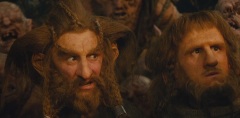
 Much like Bifur’s Axe-in-the-head feature, only avid fans following the making of the films would have read about Nori and his skills as a thief. No general audience member, having seen the theatrical cut, would have been able to deduce this aspect of his character – which makes me even more frustrated at the lack of overall dwarf exposition in AUJ.
Much like Bifur’s Axe-in-the-head feature, only avid fans following the making of the films would have read about Nori and his skills as a thief. No general audience member, having seen the theatrical cut, would have been able to deduce this aspect of his character – which makes me even more frustrated at the lack of overall dwarf exposition in AUJ.
The Great Goblin remains unimpressed, shrugging off the silverware as “Second Age” – somewhat putting to shame the pride and dignity of the Company.
– Overall Verdict
Whilst it lacks the in-depth expositions, backstory information and immense breadth to the world in ‘The Lord of the Rings’ extended editions, most of the 13 minutes help to “ease” some of the editorial mishaps done in the theatrical cut of ‘An Unexpected Journey’; whilst at the same time, providing some much required material to the narrative as it expands over films 2 and 3.
If you enjoyed watching ‘An Unexpected Journey’, then I definitely suggest you watch the extended edition … not the least, in anticipation for the release of ‘The Desolation of Smaug’.
Go on! Quench that thirst for Middle-earth right now!
4/5 stars 🙂
[All screenshots belong to New Line Cinema, Warner Bros. and MGM Studios]
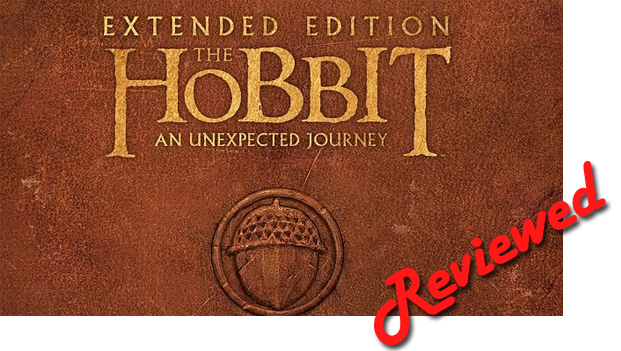
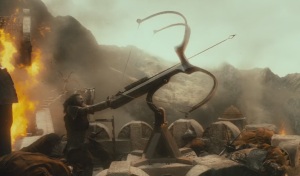
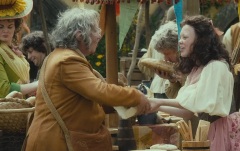

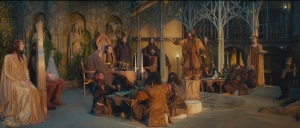
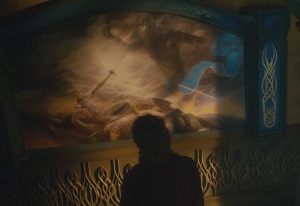

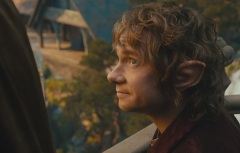

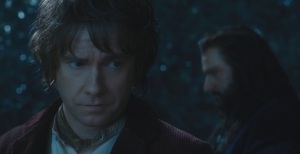
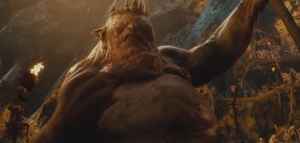
I can’t read your post just yet as I still haven’t got my hands on The DVD, but will return when I’ve spent the 1257 hours going through it 😉
Heh! No problem 😉 I will patiently await your feedback …
My favorite parts are Rivendell scenes except for the path thing wis was not necessary and The Goblin King song was amazing.
Definitely agree about the Rivendell scenes! 🙂
Sounds pretty cool. Not thrilled about the Fountain Part though…
Hehe seems like Im not the only one then!
😛
great post. I watched some of these scenes on youtube but not all of them. I never noticed the toy that Bilbo was holding looked like Sting (good eyes). I also agree about the Dwarves bathing scene….wasn’t needed.
I’m not sure why they didn’t include the Bifur scene. It seemed like it took up all of 15 seconds. And explained so much about him.
Exactly. Sometimes I wondering what Peter and Jabez Olssen (the editor) were thinking …
Reblogged this on Confessions of a Geek Queen.
I could have done without Bilbo’s voiceover for the Thranduil feud. The whole feeling of “if only they could have gotten along” felt sort of lame, or maybe just uninformed, considering everything that happened after. I know that hobbits are supposed to value peace and have trouble with folks who go to war over petty things like theft of services *cough*dwarfperspective*cough* but I think he would understand the behavior of the two parties better by that point.
Agreed. Sometimes, less is more and in this case, maybe Ian Holm’s voice over may not have been the best of options.